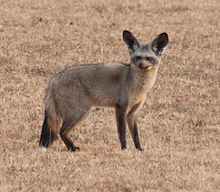Bat-eared fox
| Bat-eared fox[1] | |
|---|---|

| |
| Scientific classification | |
| Kingdom: | |
| Phylum: | |
| Class: | |
| Order: | |
| Family: | |
| Subfamily: | |
| Genus: | Otocyon Müller, 1835
|
| Species: | O. megalotis
|
| Binomial name | |
| Otocyon megalotis (Desmarest, 1822)
| |

| |
| Bat-eared fox range | |

The bat-eared fox (Otocyon megalotis) is a canid of the African savanna, named for its large ears. Fossil records show this canid to first appear during the middle Pleistocene, about 800,000 years ago.[3]
The bat-eared fox (Otocyon megalotis), also referred to as big-eared fox, black-eared fox, cape fox, and Delalande’s fox has tawny fur with black ears, legs and parts of the pointed face. It averages 55 cm in length (head and body), with ears 13 cm long. It is the only species in the genus Otocyon.[1] The name Otocyon is derived from the Greek words "otus" for ear and "cyon" for dog, while the specific name "megalotis" comes from the Greek words "mega" for large and "otus" for ear. [4]
Distribution and Habitat
Two distinct populations of bat-eared foxes occur in Africa. O. m. megalotis occurs in the southern regions including southern Zambia, Angola, and South Africa. O. m. virgatus occurs in Ethiopia and southern Sudan extending to Tanzania.[5]
The bat-eared fox commonly occur in short grass lands as well as the more arid regions of the savanna. In addition to raising their young in dens, bat-eared foxes use self-dug dens for shelter from extreme temperatures and winds. [6]
Diet
The bat-eared fox is an insectivore that uses its large ears to locate its prey. 80-90% of their diet is harvester termites, (Hodotermes mossambicus). When this particular species of termite is not available bat-eared foxes feed on other species of termites and have also been observed consuming ants, beetles, crickets, grasshoppers, millipedes, moths, scorpions, spiders, and rarely birds, small mammals, and reptiles. The insects they eat fulfill the majority of their water intake needs. [7]
Dentition
The teeth of the bat-eared fox are much smaller and reduced in sheering surface formation than teeth of other canid species. This is an adaptation to its insectivorous diet.[8] Due to its unusual teeth, the bat-eared fox was once considered as a distinct subfamily of canids (Otocyoninae). However, according to more recent examinations, it is more closely related to the true foxes of the genus Vulpes.[citation needed] Other research places the genus as an outgroup which is not very closely related to foxes. The bat-eared fox is an old species that was widely distributed in the Pleistocene era.
Behavior
Reproduction
The bat-eared fox is predominantly monogamous, although has been observed in polygynous groups. In contrast to other canids, the bat-eared fox has a reversal in parental roles with the male taking on the majority of the parental care behavior. Females gestate for 60-70 days and give birth to litters consisting of 1 to 6 pups. Beyond lactation, which lasts 14 to 15 weeks[9], males take over grooming, defending, huddling, chaperoning, and carrying the young between den sites. Additionally, male care and den attendance rates have been shown to have a direct correlation with cub survival rates. [10] Mating season varies based on location but appears to coincide with peaks in rain and insect densities.[11]
- ^ a b Wozencraft, W. C. (2005). "Order Carnivora". In Wilson, D. E.; Reeder, D. M. (eds.). Mammal Species of the World: A Taxonomic and Geographic Reference (3rd ed.). Johns Hopkins University Press. ISBN 978-0-8018-8221-0. OCLC 62265494.
- ^ Template:IUCN2008 Database entry includes justification for why this species is of least concern
- ^ Paleobiology Database: Otocyon Basic info.
- ^ Clark, Howard (15). American Society of Mammalogists (766): 1–5.
{{cite journal}}: Check date values in:|date=and|year=/|date=mismatch (help); Missing or empty|title=(help); Unknown parameter|month=ignored (help) - ^ Clark, Howard (15). American Society of Mammalogists. 766: 1–5.
{{cite journal}}: Check date values in:|date=and|year=/|date=mismatch (help); Missing or empty|title=(help); Unknown parameter|month=ignored (help) - ^ Clark, Howard (15). American Society of Mammalogists. 766: 1–5.
{{cite journal}}: Check date values in:|date=and|year=/|date=mismatch (help); Missing or empty|title=(help); Unknown parameter|month=ignored (help) - ^ Clark, Howard (15). American Society of Mammalogists. 766: 1–5.
{{cite journal}}: Check date values in:|date=and|year=/|date=mismatch (help); Missing or empty|title=(help); Unknown parameter|month=ignored (help) - ^ Kieser, J.A. (1995). "Gnathomandibular Morphology and Character Displacement in the Bat-eared Fox". Journal of Mammalogy. 76 (2): 542–550.
{{cite journal}}: Unknown parameter|month=ignored (help) - ^ Clark, Howard (15). American Society of Mammalogists. 766: 1–5.
{{cite journal}}: Check date values in:|date=and|year=/|date=mismatch (help); Missing or empty|title=(help); Unknown parameter|month=ignored (help) - ^ Wright, Harry William Yorkstone (2006). "Paternal den attendance is the best predictor of offspring survival in the socially monogamous bat-eared fox". Animal Behaviour. 71 (3): 503–510. doi:10.1016/j.anbehav.2005.03.043.
- ^ Clark, Howard (15). American Society of Mammalogists. 766: 1–5.
{{cite journal}}: Check date values in:|date=and|year=/|date=mismatch (help); Missing or empty|title=(help); Unknown parameter|month=ignored (help)

